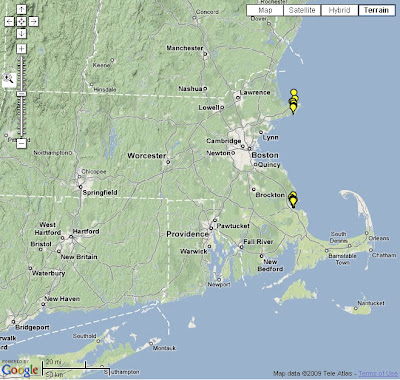-Mike
The big January news among birders in the Northeastern U.S. was ivory, especially on the coast. Snow everywhere, white caps offshore, and not one, but two Ivory Gulls hanging out on coastal Massachusetts.
That is, to put it mildly, huge. The Birds of North America Online's species account asserts that "only rarely does it occur as a winter vagrant south of the Bering Sea and Maritime Provinces."
 Expected distribution of Ivory Gull. Note that New England is
Expected distribution of Ivory Gull. Note that New England isalmost off the southern end of the map - clearly, not an
expected observation. Image courtesy of BNAOnline.
"Rare" and "vagrant." Two words that evoke a range of emotions in a birder. Awe washes over you at the prospect of seeing a bird a limited number of people have seen. Excitement at the prospect of seeing something you may never get a chance to see again in your lifetime. Depression when you realize you will likely not get a chance to even try for it.
Why depression? Consider this: the last Ivory Gull to grace the shores of Massachusetts was in 1976. Most observations are one-day wonders, most Ivory Gulls that undertake such southerly dispersions are immature birds, and most sightings are of single birds. And here were two adult birds, within an 90 minutes of each other (by car, they were within 45 miles of each other as the gull flies). An unheard of scenario in the lower 48.
So that was the progression of emotion that washed over me when I heard about the sighting, on a Monday. A few Cornell birders made the trip the days before, the weekend of the 17-18th January. I was looking at a long five days until the weekend, the next opportunity I'd have to even plan for a chase. And for a bird that is typically a one-day wonder, well, five days is five days too late - do the math, you'll see. Even if it stuck around, unfortunately for me, a weekend trip was not possible. I'd have to wait until an Ivory Gull graced the shores of one of New York's Finger Lakes, preferably nearby Cayuga or Seneca Lake.
 Map generated from eBird data, 1990 - 2009. Note the vast majority
Map generated from eBird data, 1990 - 2009. Note the vast majorityof reported sightings concentrate on the northern coast of Canada.
Enter providence: I discovered I had a "flexible Friday," meaning no pressing meetings or deadlines. I could take a personal day, making up work during the weekend. Done deal.
The Gloucester bird was iffy, reinforcing my decision on chasing the Plymouth bird. Plymouth looked to be a slightly shorter trip and (more importantly) that bird appeared to be more reliable, in no small part due to the chicken carcasses birders were leaving for it. Seriously.
Whatever the reason, positive reports came in from Plymouth late on Thursday. 4:30 Friday morning I was heading east, double fisting coffee and a bagel, finally coasting into Plymouth, MA by 10:30.
 eBird reports showing the locations of the two Ivory Gulls in
eBird reports showing the locations of the two Ivory Gulls inMassachusetts, winter 2009. The Plymouth bird (southern cluster of
yellow pins) stuck around longer than the northern Gloucester bird.
Then the worry started. I knew exactly where to go, partially due to the Massachusetts birding listserve and partially to eBird's Google maps of bird sightings. But I didn't know where to park, as usual I had no change for parking meters . . . . Turns out my irrational fears continue to be unfounded. Many parking lots, some permit only but I found a spot for visitors.
I called Marshall Iliff, the one-third of the current eBird team who conveniently lives in Boston, as I started unloading the scope and camera from the back seat. As we made lunch plans I scanned the harbor, my bins settling on a white bird following a small group of gulls. I stopped in mid sentence, realizing this white bird was all white, like one of those white pigeons that stand out in ubiquitous flocks of Rock Pigeons in any urban or rural areas. In fact, I saw one of these albino/leucistic birds on my drive through Plymouth, not realizing how close it would resemble the bird I crossed state lines to see.
I don't know which expletive I chose, but I do remember announcing, "I just saw it." Another wash of emotion: it's still around, I saw where it landed, now I can saunter over and enjoy leisurely but chillingly delicious looks at this rare vagrant.
More follows . . .
-



2 comments:
I knew you went for the Gull and I've been looking forward to this post for some time. If for no other reason than to refuel my latent jealousy at missing this very bird.
It took me way to long to get this out there, but it was worth taking my time to do the bird justice. Very interesting vagrancy this year; if this becomes the norm you'll have more chances!
I found it coincidental that I posted my "follow up" on the same day Birding arrived with the Plymouth bird featured in the "Sightings" column. The sighting that keeps on giving!
-Mike
Post a Comment